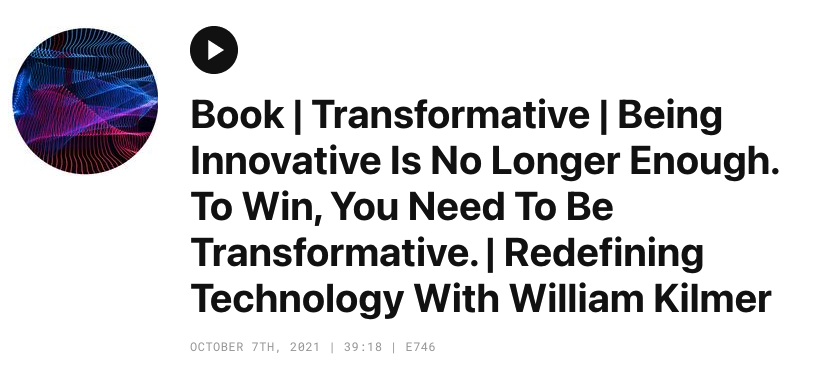|
This article features a discussion with me on the issues cybersecurity risks facing venture capital funds. The original article can be found on the Venture Capital Journal (paywall).
0 Comments
It’s been 20 years since Apple released the iPod. Here’s what we can still learn from it.10/26/2021 It’s hard to believe that twenty years ago, Steve Jobs introduced the iPod to the world. Seated at the chronological beginning of Apple’s transformation, it now receives less fanfare than the later Apple innovations, but it has cemented its place as a historically significant product. Importantly, there is still much we can learn from it as a category-creating product and how transformative companies work.
You Don’t Need to Be the First Mover to Win The first lesson was that the iPod broke the myth that you must be a first mover to lead a market. In fact, I’d argue it reinforced the maxim that, whatever the market stage, it’s better to be a market transformer than a first mover. When Apple introduced the iPod in 2001, it was just one more entrant in a sea of existing Portable Media Players (PMP). Vendors such as RCA, Sony, Intel, and Diamond Multimedia with its popular Rio line had begun launching MP3 players four years before Apple and were well established in the growing market. As a late comer, it was not a revolutionary product to begin with. The first-generation iPod’s features, particularly its signature click wheel interface, improved on existing designs, and the device maintained a good balance between cost and song capacity. But it held limited market appeal as it was compatible only with Apple’s Mac OS computers. At $399 to $499, the iPod was not an overnight success, selling an estimated 25,000 units in its first year. Outcome Innovation is Key Lesson two is what actually propelled the iPod to success, and it’s because of core principle of market transformers: they create beachheads by changing customer outcomes. Changing customer outcomes involves helping the customer reach their intended goal, or solve their problem, with an accompanying set of new benefits. These new benefits flip the script for customers and the leading indicator that you’ve achieved it is that customers make their purchase decision based on a new and different set of purchase criteria. This creates a new basis of competition—the reason why a customer buys one solution over another. Apple achieved it with the launch of the iTunes Music store two years after releasing the iPod. They created a new category of personal music players by combining the iPod with the iTunes store, giving customers access to buy and download songs directly. This solved a significant problem of buying music and loading it on a portable device and unbundled music in a way that gave customers a new reason to buy. This produced a change of value by upleveling the outcome to achieve the customer goal to conveniently find and play the music they love. As a category creator, Apple quickly grew to dominate the market, and iPod sales rose fourfold the next year and fivefold in 2005. By 2006, five years after its release, the iPod accounted for 40 percent of Apple’s revenues. It also revealed a separate type of innovation that brings us to lesson three. Structural Innovation Is Self-Reinforcing Along with innovating a great customer outcome, Apple demonstrated the power of structural innovation. While outcome innovation opens the door for new entrants, structural innovation closes the door on incumbents by encouraging leaders to look at creatively changing the company’s capabilities, resources, relationships, assets, knowledge, and the industry structure required to deliver a better customer outcome. It involves actively changing how something is delivered to produce something entirely new. The power of structural innovation is in going after what incumbents do well. Apple’s convergence of media and devices started with the iPod. Using the iTunes Store, Apple created a seamless solution that allowed users to easily buy and down- load new music, creating the ideal user experience and disrupting the music player market with something that the incumbents were not prepared to provide. What Apple created was a product that was not only more valuable and differentiated, but one in which incumbents couldn’t recreate because it went against what they did well. Soon creating a platform for content became a significant differentiator for Apple that no one else could adequately replicate. It Starts with Intentionality The next lesson is that Apple created great products because Steve Jobs was a master at creating intentionality—the ability to define a product with enough vision to capture the customer feel, but open enough to enlist the organization to help define it. He was relentless and often ruthless in pursing that vision that creates something that is valuable and differentiated. Jobs had a history of using intentionality. He used it to drive Apple to develop a personal computer that would “change the world.” That was exhibited in its famous 1984 advertisement that symbolized Apple freeing the world from the oppression of the IBM Personal Computer. He used intentionality again when developing the first iPod, making it clear that the vision was to “Put 1,000 songs in your pocket.” When the iPhone was under development, the intentionality was to “Make the phone the killer app.” It’s Critical to Innovate for Market Leadership Next, Apple understood the importance of innovating for market leadership. This means not just innovating the product but innovating to win a new and larger market they helped create. It’s manifested in many ways, but here are two examples. The first is that organization has always found an advantage in focusing on the art of reduction. “Simplicity is the ultimate sophistication” was the headline of Apple’s first marketing brochure back in 1977. “It takes a lot of hard work,” CEO Steve Jobs once said, “to make something simple, to truly understand the underlying challenges and come up with elegant solutions.” When Apple launched the iPod, that philosophy of focusing on simplicity came through again. He assessed that competitors’ products were too complicated. “What made the Rio and other devices so brain dead was that they were complicated,” Jobs observed. “They had to do things like make playlists because they weren’t integrated with the jukebox software on your computer. So, by owning the iTunes software and the iPod device, that allowed us to make the computer and the device work together, and it allowed us to put the complexity in the right place.” Along with simplicity, business model innovation is a market accelerator and expander. In fact, great technology almost always comes with business model innovation. The launch of the iTunes Store was a turning point for iPod customers and Apple as a company. With iTunes, Apple provided a completely new outcome to customers that combined both devices and access to digital music. For the first time, users had a seamless way to search for, purchase, and download music directly onto their device. It also gave customers the freedom to buy individual songs instead of being forced to buy an entire album, giving customers the option to pick the music they wanted. The iTunes Store also provided Apple with an additional revenue stream beyond selling the original device, which its portable media player competitors lacked. That revenue stream, in tandem with iPod sales, was a powerful growth engine for Apple. Revenue from the iPod peaked at around $4 billion for Apple in the first quarter of 2008. Total sales from iPods reached $9.2 billion that same year, while the iTunes store brought approximately $3.3 billion in revenue. For every $3 in revenue from iPods, Apple made an additional $1 in music sales, a revenue stream that no other vendor of personal media players could achieve. In less than four years, Apple had successfully shifted a revenue stream from the music industry to add more than $3 billion to its own top line. While iTunes music sales have peaked, Apple has tapped additional sales in video, applications, and books. In 2020 Apple added an estimated $54 billion in revenue from sales of media, which has more than doubled since 2016. That is nearly six times the peak annual sales of iPods. Great Companies Kill Their Own Products Finally, we also learn from Apple that great companies know how to kill their own products. On June 29, 2007, Steve Jobs opened the iPhone launch event in San Francisco, announcing that Apple was launching three revolutionary products that day: a widescreen iPod with touch controls, a revolutionary mobile phone, and a breakthrough Internet communications device. A few minutes into the presentation, it became evident that those three products were actually just one device, the iPhone. Eventually the iPhone replaced the iPod’s functionality, as Apple Music has likely become the dominant revenue stream (Apple doesn’t break out their Apple Music revenue). Apple’s focus on the customer outcome rather than the product has enabled them to transition customers from one solution to the next by focusing on the best solution they can deliver with new customer outcomes instead of worrying about product cannibalization. The iPod set off a revolution inside of Apple, breaking them out of their reliance on the computer market and delivered multiple new products and revenue streams for the company. Importantly, it also gave us much to learn how to approach new and existing markets with game-changing innovation. William Kilmer is a venture capital investor at C5 Capital, former CEO and managing director at Intel Capital. He is the author of the upcoming book, Transformative: Build a Game-Changing Strategy, Retool Your Organization, and Innovate to Win. For more information, visit Williamkilmer.com ITSP Magazine Podcast Interview with Marco Ciappelli and Sean Martin. To listen to the episide visit the ITSP episode web page.
Summary Companies are putting more resources than ever into producing innovative solutions, yet nearly every executive expresses some level of dissatisfaction with their company's innovation performance. That's because while innovation is still critical, it's no longer enough. Episode Notes Companies are putting more resources than ever into producing innovative solutions, yet nearly every executive expresses some level of dissatisfaction with their company's innovation performance. That's because while innovation is still critical, it's no longer enough. Join us as we talk to a technological thought leader and investor, William Kilmer. Together, we explore why organizations need to step back and build a strategy that not only will produce great products, but that can transform the market. What allows a company to transform is to understand societal and cultural changes that are or are about to take place. If they can foster their teams to develop a strategy beyond being first to the market or leader in the industry but to reach, serve, and create loyalty uniquely and innovatively to customers in that market segment. All of this will likely require that the organization re-tool itself for innovation. This doesn't magically happen; teams don't just start producing something innovative. Instead, the individuals and the teams themselves become innovative. This is transformation. “Transformative companies aren’t first movers who invent new products; they’re game-changers whose category-creating solutions deliver new and better customer outcomes, altering industry structure, and radically changing and reframing existing markets.” About The Book "I wrote Transformative as a framework that will help companies build the momentum and strategy to become a game-changing organization. Behind it is the principle that companies that accept the rules of the market are condemned to live by them and limit their ability to compete to a narrow set of product features and performance. Those that open themselves to a broader view of how to innovate to win have many more options for success." Episode summary and notes are curtoesy of the ITSP Magazine Website. |
AboutLeadership Matters is a blog and newsletter that provides insight and practical guidance to help readers leverage intentional leadership and organizational culture to create more innovative, engaging, and agile organizations. Archives
April 2024
Categories |



 RSS Feed
RSS Feed